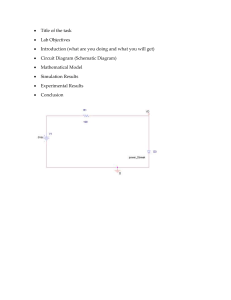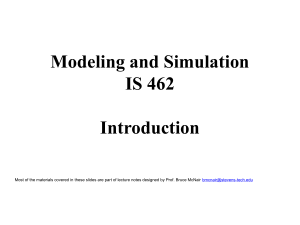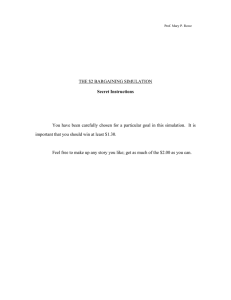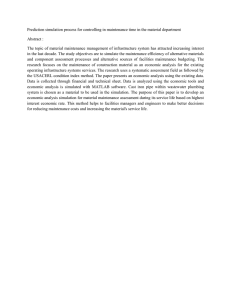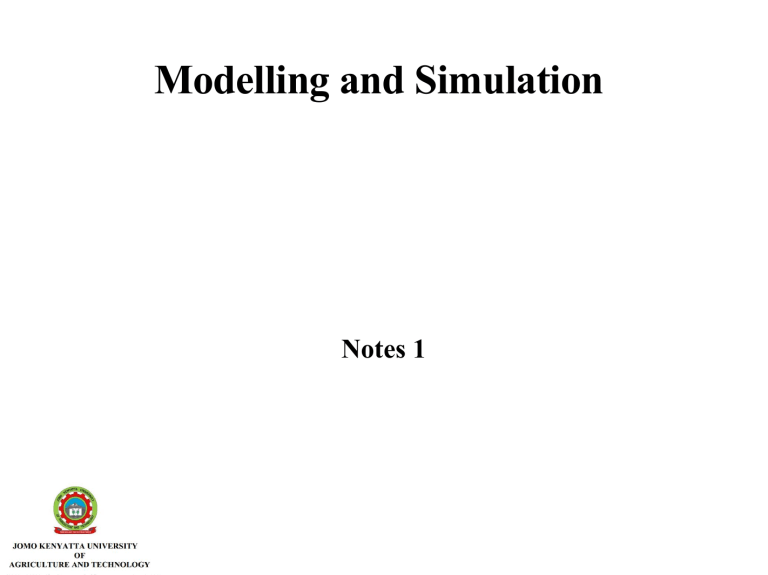
Modelling and Simulation Notes 1 Introduction Computer simulation is a powerful methodology for design and analysis of complex systems. The overall approach in computer simulation is to represent the dynamic characteristics of a real world system in a computer model. The model is subjected to experiments to obtain predictive information useful in making informed decision making about the characteristics of the real system. Simulations are suitable for problems in which there are no closedform analytical solutions. Since most dynamic problems in practice can not be represented and solved fully using mathematical equations, computer simulation is a powerful and flexible methodology in complex systems analysis. Introduction Simulations can be classified into continuous and discrete simulations. In continuous simulations, the state variables, i.e., the collection of variables needed to describe the system, change continuously over time and the behavior of the system is typically described by differential equations. Examples of continuous systems include the modeling of thermal or hydraulic systems. Discrete simulations are event-driven where the state variables change at discrete time points. Examples of discrete-event simulations include service industry applications such as queues in a grocery store and manufacturing applications involving material flow analysis. Introduction In general we have three different methods to study a real system as shown in the figure below Introduction We can therefore say that with Simulation; • Simulated system imitates operation of actual system over time. • Artificial history of system can be generated and observed. • Internal (perhaps unobservable) behavior of system can be studied. • Time scale can be altered as needed • Conclusions about actual system characteristics can be inferred. Introduction In the below figure, actual system (real system) is compared with simulation. Introduction Formal Definition Simulation can be broadly defined as a technique for studying realworld dynamical systems by imitating their behavior using a mathematical model of the system implemented on a digital computer. Simulation is Interdisciplinary Introduction Application Areas of Simulation • • • • • • • Manufacturing Computer Systems E-business/workflow systems Finance Telecommunications Transportation Military Advantages and Disadvantages of Simulation Advantages of Simulation • • • • Simulation reduces model complexity. Circumvents analytically intractable models. Facilitates what-if and sensitivity analyses. Building a model can lead to system improvements and greater understanding • Can be used to verify analytic solutions Disadvantages of Simulation • Simulation provides only estimates of solution. • Only solves one parameter at a time. • Can take a large amount of development and/or computer time Difficulties of Simulation • • • • • • Provides only individual, not general solutions Manpower and time-consuming Computing memory and time-intensive Difficult so experts are required Hard to interpret results Expensive When to Use Simulation? • Study internals of a complex system e.g. biological system • Optimize an existing design e.g. routing algorithms, assembly line • Examine effect of environmental changes e.g. weather forecasting • System is dangerous or destructive e.g. atom bomb, atomic reactor, missile launching Study importance of variables • Verify analytic solutions (theories) • Test new designs or policies • Impossible to observe/influence/build the system • When it allows inspection of system internals that might not otherwise be observable • Observation of the simulation gives insights into system behavior When to Use Simulation? • System parameters can be adjusted in the simulation model allowing assessment of their sensitivity (scale of impact on overall system behavior) • Simulation verifies analysis of a complex system, or can be used as a teaching tool to provide insight into analytical techniques • A simulator can be used for instruction, avoiding tying up or damaging an expensive, actual system (e.g., a flight simulation vs. use of multimillion dollar aircraft) Modelling Concepts There are several concepts underlying simulation. These include system and model, events, system state variables, entities and attributes, list processing, activities and delays, and finally the definition of discrete-event simulation. The process of making and testing hypotheses about models and then revising designs or theories has its foundation in the experimental sciences. Similarly, computational scientists use modeling to analyze complex, real-world problems in order to predict what might happen with some course of action. System, Model and Events A model is a representation of an actual system • It is an abstraction of the real system • Simplifying assumptions are used to capture (only) important behaviors • Linearization, time-bound behaviors, etc., may make analysis tractable The figures below presents modelling and simulation concepts as introduced by Zeigler Modeling is the application of methods to analyze complex, realworld problems in order to make predictions about what might happen with various actions. Object is some entity in the Real World. Such an object can exhibit widely varying behavior depending on the context in which it is studied, as well as the aspects of its behavior which are under study. Base Model is a hypothetical, abstract representation of the object's properties, in particular, its behavior, which is valid in all possible contexts, and describes all the object's facets. A base model is hypothetical as we will never in practice be able to construct/represent such a total model. The question whether a base model exists at all is a philosophical one. System is a well defined object in the Real World under specific conditions, only considering specific aspects of its structure and behavior Experimental Frame When one studies a system in the real world, the experimental frame (EF) describes experimental conditions (context), aspects, within which that system and corresponding models will be used. As such, the Experimental Frame reflects the objectives of the experimenter who performs experiments on a real system or, through simulation, on a model. Event is an occurrence that changes the state of the system. Events include the arrival of a customer for service at the bank, the beginning of service for a customer, and the completion of a service. There are both internal and external events, also called endogenous and exogenous events, respectively. For example, an endogenous event in the example is the beginning of service of the customer since that is within the system being simulated. An exogenous event is the arrival of a customer for service since that occurrence is outside of the simulation. However, the arrival of a customer for service impinges on the system, and must be taken into consideration. Modeling and Simulation Discrete-event simulation models Discrete-event simulation models are contrasted with other types of models such as mathematical models, descriptive models, statistical models, and input-output models. A discrete-event model attempts to represent the components of a system and their interactions to such an extent that the objectives of the study are met. Most mathematical, statistical, and input output models represent a system's inputs and outputs explicitly, but represent the internals of the model with mathematical or statistical relationships. An example is the mathematical model from physics, Force = Mass × Acceleration Functional Elements of a Measurement System Discrete-event models are dynamic, i.e., the passage of time plays a crucial role. Most mathematical and statistical models are static in that they represent a system at a fixed point of time. Consider the annual budget of a firm. This budget resides in a spreadsheet. Changes can be made in the budget and the spreadsheet can be recalculated, but the passage of time is usually not a critical issue. Models have Many Uses, Typically • To understand the behavior of an existing system (why does my network performance die when more than 10 people are at work?) • To predict the effect of changes or upgrades to the system (will spending 100,000 on a new switch cure the problem?) • To study new or imaginary systems (let’s be in the Ethernet and design our own scalable custom routing network) System State Variables The system state variables are the collection of all information needed to define what is happening within the system to a sufficient level (i.e., to attain the desired output) at a given point in time. The determination of system state variables is a function of the purposes of the investigation, so what may be the system state variables in one case may not be the same in another case even though the physical system is the same. Determining the system state variables is as much an art as a science. However, during the modeling process, any omissions will readily come to light. (And, on the other hand, unnecessary state variables may be eliminated.) System State Variables Having defined system state variables, a contrast can be made between discrete-event models and continuous models based on the variables needed to track the system state. The system state variables in a discrete-event model remain constant over intervals of time and change value only at certain well defined points called event times. Continuous models have system state variables defined by differential or difference equations giving rise to variables that may change continuously over time. Some models are mixed discrete-event and continuous. There are also continuous models that are treated as discrete-event models after some re-interpretation of system state variables, and vice versa. Entities and Attributes An entity can be dynamic in that it "moves" through the system, or it can be static in that it serves other entities. In the bank example, the customer is a dynamic entity, whereas the bank teller is a static entity. An entity may have attributes that pertain to that entity alone. Thus, attributes should be considered as local values. In the example, an attribute of the entity could be the time of arrival. Attributes of interest in one investigation may not be of interest in another investigation. Thus, if red parts and blue parts are being manufactured, the color could be an attribute. From this example, it can be seen that many entities can have the same attribute or attributes. Resources A resource is an entity that provides service to dynamic entities. The resource can serve one or more than one dynamic entity at the same time, i.e., operate as a parallel server. A dynamic entity can request one or more units of a resource. If denied, the requesting entity joins a queue, or takes some other action (i.e. diverted to another resource, ejected from the system). (Other terms for queues include files, chains, buffers, and waiting lines.) If permitted to capture the resource, the entity remains for a time, then releases the resource. There are many possible states of the resource. Minimally, these states are idle and busy. But other possibilities exist including failed, blocked, or starved. List Processing Entities are managed by allocating them to resources that provide service, by attaching them to event notices thereby suspending their activity into the future, or by placing them into an ordered list. Lists are used to represent queues. Lists are often processed according to FIFO (first-in first-out), but there are many other possibilities. For example, the list could be processed by LIFO (lastin-first out),according to the value of an attribute, or randomly, to mention a few. An example where the value of an attribute may be important is in SPT (shortest process time) scheduling. In this case, the processing time may be stored as an attribute of each entity. The entities are ordered according to the value of that attribute with the lowest value at the head or front of the queue Activities and Delays An activity is duration of time whose duration is known prior to commencement of the activity. Thus, when the duration begins, its end can be scheduled. The duration can be a constant, a random value from a statistical distribution, the result of an equation, input from a file, or computed based on the event state. For example, a service time may be a constant 10 minutes for each entity, it may be a random value from an exponential distribution with a mean of 10 minutes, it could be 0.9 times a constant value from clock time 0 to clock time 4 hours, and 1.1 times the standard value after clock time 4 hours, or it could be 10 minutes when the preceding queue contains at most four entities and 8 minutes when there are five or more in the preceding queue. Activities and Delays A delay is an indefinite duration that is caused by some combination of system conditions. When an entity joins a queue for a resource, the time that it will remain in the queue may be unknown initially since that time may depend on other events that may occur. An example of another event would be the arrival of a rush order that preempts the resource. When the preempt occurs, the entity using the resource relinquishes its control instantaneously. Another example is a failure necessitating repair of the resource. Discrete-event simulations contain activities that cause time to advance. Most discrete-event simulations also contain delays as entities wait. The beginning and ending of an activity or delay is an event. Model Classifications Several classification categories for models exist. A system exhibits probabilistic or stochastic behavior if an element of chance exists. For example, the path of a hurricane is probabilistic. In contrast, a behavior can be deterministic, such as the position of a falling object in a vacuum. Similarly, models can be deterministic or probabilistic. A probabilistic or stochastic model exhibits random effects, while a deterministic model does not. The results of a deterministic model depend on the initial conditions. Classification of Different Types of Model Discrete-Event Simulation Model • simulation model in which the state variables change only at discrete points in time at which events occur. • Events occur as a consequence of activity times and delays. • Entities may compete for system resources, possibly joining queues while waiting for an available resource. • Activity and delay times may "hold" entities for durations of time. • A discrete-event simulation model is conducted over time ("run") by a mechanism that moves simulated time forward. • The system state is updated at each event along with capturing and freeing of resources that may occur at that time. Stochastic and Deterministic Systems • A system exhibits probabilistic or stochastic behavior if an element of chance exists. Otherwise, it exhibits deterministic behavior. • A probabilistic or stochastic model exhibits random effects, while a deterministic model does not. • Deterministic: Randomness does not affect the behavior of the system. The output of the system is not a random variable. • Stochastic: Randomness affects the behavior of the system. The output of the system is a random variable. Static and Dynamic Simulations • We can also classify models as static or dynamic. • In a static model, we do not consider time. For example, a model of the weight of a salamander as being proportional to the cube of its length as a variables for weight and length, but not for time. • By contrast, in a dynamic model, time changes. For example, the number of salamanders in an area undergoes development changes with time; hence, a model of such a population is dynamic. • Therefore, a static model does not consider time, while a dynamic model changes with time. • Many of the models we will consider are dynamic and employ a static component as part of the dynamic model. Static and Dynamic Simulations • Static: A simulation of a system at one specific time, or a simulation in which time is not a relevant parameter for example, Monte Carlo & steady-state simulations. • Dynamic: A simulation representing a system evolving over time for examples, the majority of simulation problems. Discrete vs. Continuous Systems • When time changes continuously and smoothly, the model is continuous. If time changes in incremental steps, the model is discrete. • A discrete model is analogous to a movie. A sequence of frames moves so quickly that the viewer perceives motion. • However, in a live play, the action is continuous. Just as a discrete sequence of movie frames represents the continuous motion of actors, we often develop discrete computer models of continuous situations . Discrete vs. Continuous Systems • When time changes continuously and smoothly, the model is continuous. If time changes in incremental steps, the model is discrete. • A discrete model is analogous to a movie. A sequence of frames moves so quickly that the viewer perceives motion. • However, in a live play, the action is continuous. Just as a discrete sequence of movie frames represents the continuous motion of actors, we often develop discrete computer models of continuous situations . • In a continuous model, time changes continuously, while in a discrete model time changes in incremental steps. Discrete vs. Continuous Systems Continuous: State variables change continuously as a function of time and generally analytical method like deductive mathematical reasoning is used to define and solve the system. State Variable (S.V.) = f (t) Discrete vs. Continuous Systems Discrete: State variables change at discrete points in time and generally numerical method like computational procedures is used to solve mathematical models. State Variable(S.V.) = f(n t) Examples of Different Systems • Queue length at a cash machine: Stochastic, Discrete Time, Discrete System • The motion of the planets: Deterministic, Continuous Time, Discrete System • Logic circuit in a computer: Deterministic, Discrete Time, Discrete System • Flow of air around a car: Deterministic, Continuous Time, Continuous System • Closing prices of the 30 DAX shares: Stochastic, Discrete Time, Discrete System A Classic Example of Queue at Bank Counter • Queues are buffers to smooth out differences in arrival rates and service times. • At bank counter customers arrive at random intervals and suppose there is only one cashier ,Customers must wait in a queue. • Service times at the cashier are also random. Measured interarrival times (seconds):25, 111, 56, 232, 97, 452, 153, 45,...Measured service times (seconds): 45, 32, 11, 61, 93, 56, 30,... Now compute average length of queue and probability that cashier is busy. the the the the Computer Workload and Preparation of its Models • All simulation studies begin with a specification of objectives and problem formulation. • Model development including conceptualization implementation follows the formulation. and • Data are collected from the real world early during model development to adequately provide the parameters of the model entities. • Decisions need to be made during the implementation phase on the choice of the platform, language, analysis methods, etc. • The implemented model must be verified for accuracy and validated for correspondence to the real-world system being represented. Computer Workload and Preparation of its Models • The simulation is run several times and statistical analyses of the output data are conducted before a modeler provides recommendations based on the simulation study. • The processes involved in simulation modeling and analysis are not strictly linear. • An analyst may iterate between different stages in computer simulation development including problem formulation, model abstraction, implementation, verification and validation, and output analysis. Steps of the Modeling Process The modeling process is cyclic and closely parallels the scientific method and the software development life cycle (SDLC) for the development of a major software project. The process is cyclic because at any step we might return to an earlier stage to make revisions and continue the process from that point. Steps of the Modeling Process The steps of the modeling process are as follows: 1. Analyze the Problem We must first study the situation sufficiently to identify the problem precisely and understand its fundamental questions clearly. At this stage, we determine the problem’s objective and decide on the problem’s classification, such as deterministic or stochastic. Only with clear, precise problem identification can we translate the problem into mathematical symbols and develop and solve the model. Steps of the Modeling Process 2. Formulate a Model In this stage, we design the model, forming an abstraction of the system we are modeling. For example, in a service industry application, simulations of banking systems can be used to evaluate the tradeoffs associated with having an additional teller. The performance measures of the system being studied must be made explicit during the problem formulation stage. In the banking system example, performance measures include average customer waiting time, teller utilization, etc. Steps of the Modeling Process Decisions on whether simulation is an appropriate methodology must also be made carefully during this stage. Some of the tasks of this step are as follows: a. Gather Data We collect relevant data to gain information about the system’s behavior b. Make Simplifying Assumptions and Document them In formulating a model, we should attempt to be as simple as reasonably possible. Thus, frequently we decide to simplify some of the factors and to ignore other factors that do not seem as important. Most problems are entirely too complex to consider every detail, and doing so would only make the model impossible to solve or to run in a reasonable amount of time on a computer. Steps of the Modeling Process 3. Model Abstraction • Following problem formulation, the analyst abstracts relevant features of the system to be represented in the model. • Depending on the goals of the simulation study, the analyst decides on the appropriate level of detail or granularity of the model. • Aspects of the system relevant to the simulation must be specified. • Once the scope has been sufficiently limited, the system boundaries can be drawn. • Bounding the system is a very important analytical step because it defines internal and external factors as well as inputs and outputs. The process of bounding the system can help to reduce the level of complexity by reducing the size of the system in some cases. Steps of the Modeling Process 3. Determine Variables and Units We must determine and name the variables. An independent variable is the variable on which others depend. In many applications, time is an independent variable. The model will try to explain the dependent variables. For example, in simulating the trajectory of a ball, time is an independent variable; and the height and the horizontal distance from the initial position are dependent variables whose values depend on the time. To simplify the model, we may decide to neglect some variables (such as air resistance), treat certain variables as constants, or aggregate several variables into one. While deciding on the variables, we must also establish their units, such as days as the unit for time. Steps of the Modeling Process 3. Determine Variables and Units (Continued) The process involves; a. Establish Relationships Among Variables and Submodels If possible, we should draw a diagram of the model, breaking it into submodels and indicating relationships among variables. b. Determine Equations and Functions While establishing relationships between variables, we determine equations and functions for these variables. For example, we might decide that two variables are proportional to each other, or we might establish that a known scientific formula or equation applies to the model. Steps of the Modeling Process 5. Solve the Model This stage implements the model. Some of the techniques and tools that the solution might employ are algebra, calculus, graphs, computer programs, and computer packages. Our solution might produce an exact answer or might simulate the situation. If the model is too complex to solve, we must return to Step 2 to make additional simplifying assumptions or to Step 1 to reformulate the problem. Steps of the Modeling Process 6. Model Implementation The fundamental problem in model implementation is to translate the conceptual model to a simulation program using the constructs of a simulation or software package. The conceptual model generated during the earlier phase must be implemented in the form of a simulation program. During implementation, an analyst can use a simulation language such as SIMAN or GPSS, or standard programming languages such as C, C++, or Java, or special simulators tailored for specific applications. Some languages have a graphical front end to configure a system simulation. The graphical environment is intended for analysts without programming background to rapidly simulate and analyze a specific system. Steps of the Modeling Process 7. Verify and Interpret the Model’s Solution Once we have a solution, and the model’s solution is used, it may be necessary or desirable to make corrections, improvements, or enhancements. In this case, the modeler again cycles through the modeling process to develop a revised solution. We should carefully examine the results to make sure that they make sense (verification) and that the solution solves the original problem (validation) and is usable. The process of verification determines if the solution works correctly, while the process of validation establishes if the system satisfies the problem’s requirements. Steps of the Modeling Process 7. Verify and Interpret the Model’s (Solution Continued) Thus, verification concerns “solving the problem right,” and validation concerns “solving the right problem. Testing the solution to see if predictions agree with real data is important for verification. Ultimately, the model must accurately predict the system performance for a range of input conditions. The simulation should be robust enough to yield accurate results when assumptions and parameters are varied. Steps of the Modeling Process 8. Execution From an output analysis perspective, there are two types of execution modes: terminating and steady state. The terminating mode is appropriate for systems that start and run for a time then stops for some period. An example of this kind of operation is a store that closes overnight. A steady state simulation is suitable for a system that operates continuously, such a power generating plant or a hospital emergency room. The widest possible set of initial conditions should be tried in both cases. Steps of the Modeling Process 9. Output Analysis The basic goal here is to determine the variability in the estimators chosen to evaluate the system. Appropriate statistical methods should be applied to determine the degree of correspondence between the outputs of the model and those of the real system. These methods will vary depending upon whether a terminating or steady state simulation is being analyzed. Steps of the Modeling Process 10. Report on the Model Reporting on a model is important for its utility. Perhaps the scientific report will be written for colleagues at a laboratory or will be presented at a scientific conference. A report contains the following components, which parallel the steps of the modeling process; a. Analysis of the problem Usually, assuming that the audience is intelligent but not aware of the situation, we need to describe the circumstances in which the problem arises. Then, we must clearly explain the problem and the objectives of the study. Steps of the Modeling Process b. Model design The amount of detail with which we explain the model depends on the situation. In a comprehensive technical report, we can incorporate much more detail than in a conference talk. For example, in the former case, we often include the source code for our programs. In either case, we should state the simplifying assumptions and the rationale for employing them. Usually, we will present some of the data in tables or graphs. Such Figures should contain titles, sources, and labels for columns and axes. Clearly labeled diagrams of the relationships among variables and submodels are usually very helpful in understanding the model. Steps of the Modeling Process c. Model solution In this section, we describe the techniques for solving the problem and the solution. We should give as much detail as necessary for the audience to understand the material without becoming mired in technical minutia. For a written report, appendices may contain more detail, such as source code of programs and additional information about the solutions of equations. Steps of the Modeling Process c. Model solution In this section, we describe the techniques for solving the problem and the solution. We should give as much detail as necessary for the audience to understand the material without becoming mired in technical minutia. For a written report, appendices may contain more detail, such as source code of programs and additional information about the solutions of equations. d. Results and conclusions Our report should include results, interpretations, implications, recommendations, and conclusions of the model’s solution. We may also include suggestions for future work. Steps of the Modeling Process 11. Recommendation Ultimately the results are used to decide what changes to make to the real system, if any. Although planning and implementing the changes may not be the responsibility of the analysts, any recommendations for change should be described in as much detail as possible. Cost and impact analysis along with a detailed description forms a solid proposal for change
